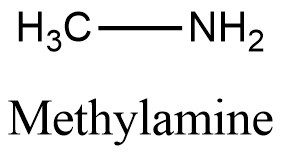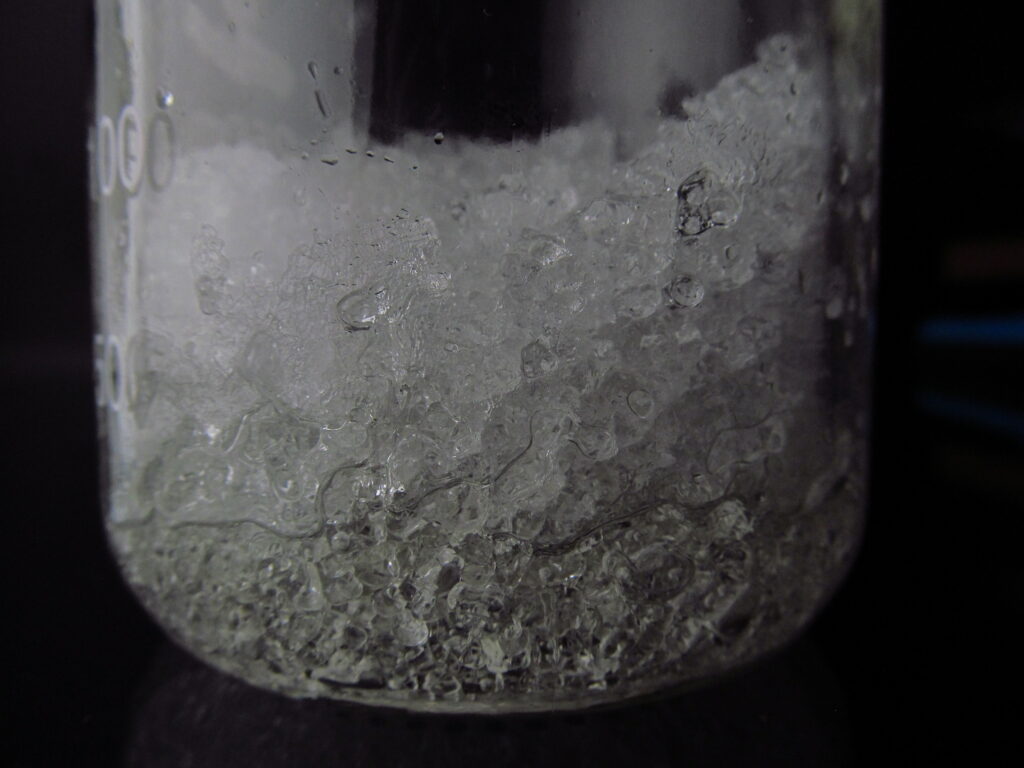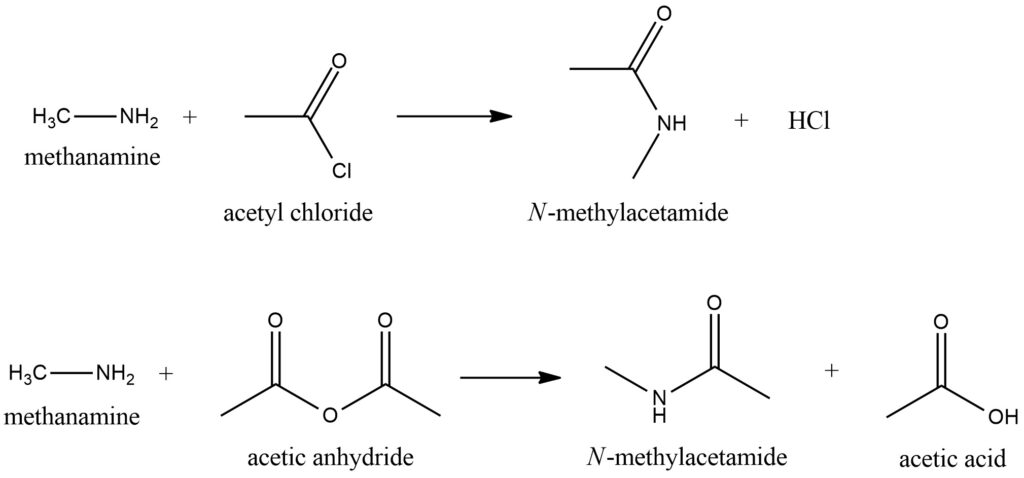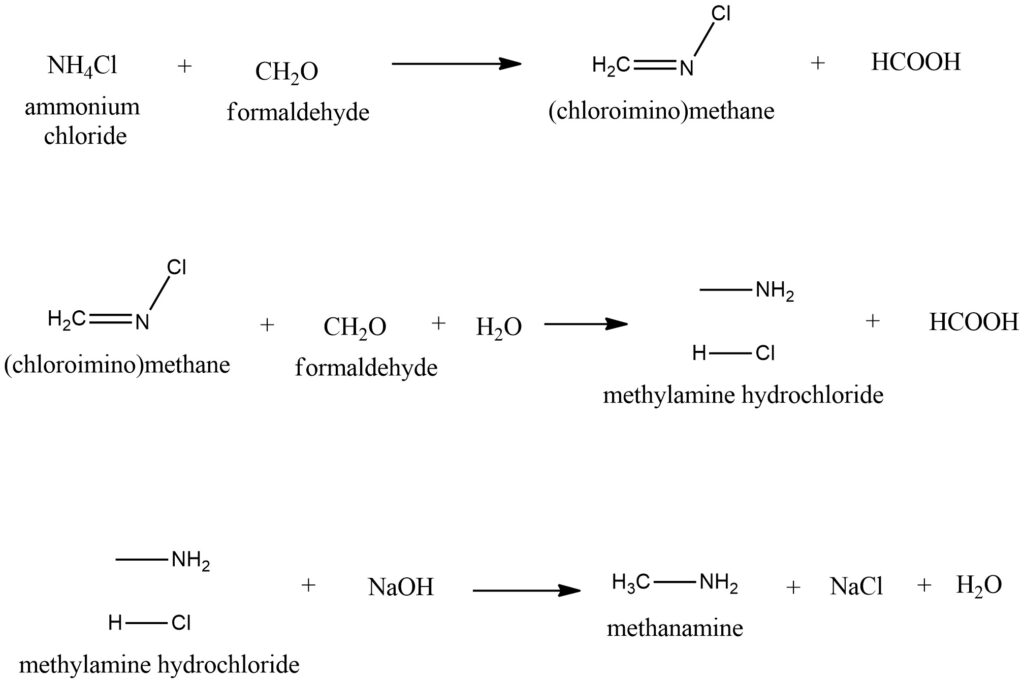- The process of creating a drug - May 23, 2023
- How do scientists model mental disorders in animals? - May 23, 2023
Methylamine: Properties, Synthesis, and Uses
What is Methylamine? Abstract.
Methylamine is an organic compound with a formula of CH3NH2. This colorless gas is a derivative of ammonia, but with one hydrogen atom being replaced by a methyl group. It is the simplest primary amine. This article presents a comprehensive overview of Methylamine, including its general information, physico-chemical properties, Chemical Reactions, synthesis of Methylamine (m-amine), conclusion, and bibliography.
General Information About What is Methylamine? [1-5]
Other synonyms names of Methylamine are: Methanamine; Aminomethane; Monomethylamine; Carbinamine; Mercurialin; N-Methylamine; Methylaminen; Metilamine; Metyloamina; Anhydrous Methylamine; Methylamine aq; monomethyl amine
IUPAC Names of Methylamine: methanamine
CAS number is 74-89-5
Related CAS numbers are 14965-49-2 (hydriodide); 17000-00-9 (hydride); 22113-87-7 (nitrate); 33689-83-7 (sulfate [2:1]); 593-51-1 (hydrochloride); 6876-37-5 (hydrobromide)
Physico-Chemical Properties [1-5]
- Molecular Formula CH3NH2
- Molar Weight 31.057 g/mol
- Melting Point -38 ℃ (Alfa Aesar) and -93℃ (Sigma-Aldrich)
- Boiling Point -6.3 ℃ (Sigma-Aldrich) and 49℃ (Alfa Aesar)
- Density 0,7 g/cm3 at 20 °C (Sigma-Aldrich) and 0.899 (Alfa Aesar)
- Solubility: Miscible with water, ethanol, benzene, acetone and ether.
- Color/Form: Color colorless Compressed gas
- Odor: Colorless gas with a fish- or ammonia-like odor
Structural formula present on Figure 1.

Crystalline solid of the m-amine hydrochloride can be seen in the picture provided in Figure 2.

Hydrochloride. What is Methylamine?
Chemical Reactions [1-7]
Methylamine, a multifaceted organic compound, finds its way into various forms, including solutions in methanol, ethanol, tetrahydrofuran, or water, as well as an anhydrous gas stored in pressurized metal containers. For industrial purposes, the anhydrous variant is transported in pressurized railcars and tank trailers. An unmistakable trait of methylamine is its potent odor, akin to that of rotten fish.
One of the primary utilities of m-amine lies as a building block in the synthesis of numerous commercially available compounds. Its relevance is further enhanced as it emerges during putrefaction and serves as a substrate for methanogenesis. Notably, m-amine production occurs during PADI4-dependent arginine demethylation.
In specific applications, a 40% w/w aqueous solution of m-amine acts as a mobile phase in perchlorate analysis, effectively analyzing milk and yogurt samples through LC-MS/MS. Moreover, m-amine plays a vital role in synthesizing 9-fluorenylmethyl N-methylcarbamate, tert-butyl N-methylcarbamate, 7-methylamino-2-(2-quinolyl)tropone, 2,5-meso-pyrrolidines, and 2-(4-chlorophenyl)-N-methylacetamide.
Caution must be exercised while handling m-amine, as it exhibits a LD50 (mouse, s.c.) of 2.5 g/kg. To safeguard against potential hazards, the Occupational Safety and Health Administration (OSHA) and National Institute for Occupational Safety and Health (NIOSH) have set occupational exposure limits at 10 ppm or 12 mg/m3 over an eight-hour time-weighted average.
Notably, in the United States, m-amine is categorized as a List 1 precursor chemical by the Drug Enforcement Administration (DEA) due to its involvement in the illicit production of methamphetamine.
Reactions
M-amine (CH3NH2) reacts with hydrochloric acid (HCl) to form a salt known as methylammonium chloride (CH3NH3Cl). Figure 3.

M-amine Oxidation on the air to Methylhydroxylamine. Figure 4.

Aminomethane participates in the amid formation reaction, where it reacts with carbonyl compounds such as aldehydes or chloranhydrides to form the corresponding methylamides. Figure 5.

M-amine participates in the imine formation reaction, where it reacts with ketones or aldehydes to form the corresponding imines. Figure 6.

The interaction of m-amine with oxalyl chloride. In laboratory practice, instead of using the gaseous and hazardous phosgene, oxalyl chloride can be used. It reacts with amines and amides to form the corresponding isocyanates, liberating carbon dioxide. Figure 7.

Methylamine’s interaction with haloalkanes (alkyl halides) leads to a reaction known as nucleophilic substitution. In this reaction, the nucleophilic nitrogen atom in m-amine attacks the electrophilic carbon atom in the haloalkane, resulting in the substitution of the halogen atom with the m-amine group. Figure 8.

Synthesis of Methylamine [8-10]
This compound was initially synthesized in 1849 by Charles-Adolphe Wurtz through the hydrolysis of methyl isocyanate and its related compounds. An illustrative method involves utilizing the Hofmann rearrangement, resulting in the production of m-amine from acetamide and bromine gas.
In laboratory settings, the preparation of its hydrochloride salt is achievable through several alternative methods. One such approach involves the reaction of formaldehyde with ammonium chloride. The resulting colorless hydrochloride salt can be transformed into an amine by introducing a potent base, such as sodium hydroxide (NaOH). Synthesis of starting from and according to the scheme Figure 9.

Another method for the synthesis involves the reduction of nitromethane using zinc and hydrochloric acid. This process is commonly known as the Leuckart-Wallach reaction. In this reaction, nitromethane (CH3NO2) reacts with zinc (Zn) and hydrochloric acid (HCl) to form m-amine (CH3NH2) as one of the products.
Conclusion
M-amine is a colorless gas with a pungent odor, soluble in water and alcohols. It serves as a precursor for the synthesis of methamphetamine, and as a result, it has been listed as a controlled substance in the USA. Commercially, it is available as m-amine hydrochloride, as well as in aqueous and alcoholic solutions.The distinctive pungent odor of m-amine can be a potential safety concern and requires careful handling during its use.
Bibliography
- https://en.wikipedia.org/
- https://pubchem.ncbi.nlm.nih.gov/compound/6329
- https://www.chemspider.com/Chemical-Structure.6089.html
- https://www.sigmaaldrich.com/GB/en/product/aldrich/295531
- https://www.alfa.com/en/catalog/L00894/
- https://en.wikipedia.org/wiki/Amide
- https://en.wikipedia.org/wiki/Isocyanate
- Marvel, C. S.; Jenkins, R. L. “M-amine Hydrochloride”. Organic Syntheses.; Collective Volume, vol. 1, p. 347, 1941. DOI: 10.15227/orgsyn.003.0067 http://www.orgsyn.org/demo.aspx?prep=cv1p0347
- Gatterman, Ludwig & Wieland, Heinrich (1937). Laboratory Methods of Organic Chemistry. Edinburgh, UK: R & R Clark, Limited. pp. 157–158.
- https://bbgate.com/threads/synthesis-of-methylamine-hcl-from-formaldehyde-large-scale.246/


![Making Methylamine HCl [NileRed re-upload]](https://i.ytimg.com/vi/wuyouolU5LY/maxresdefault.jpg)
